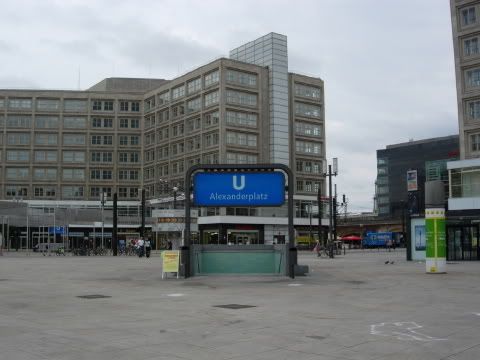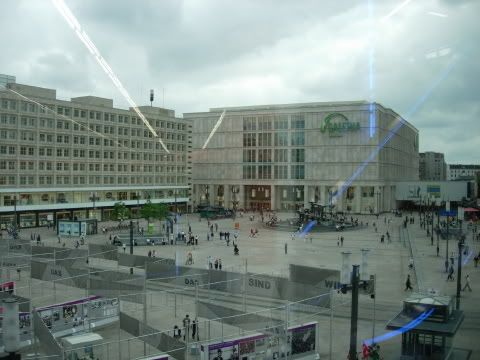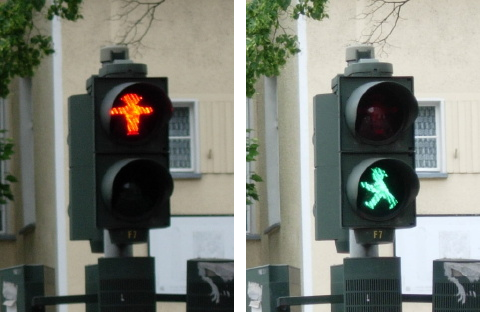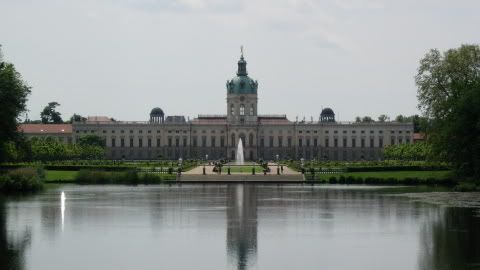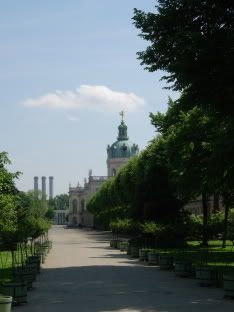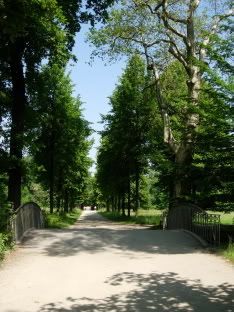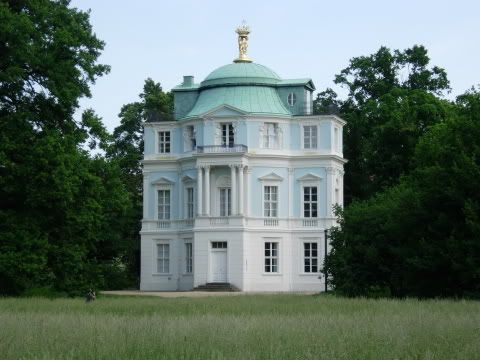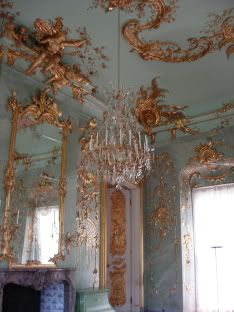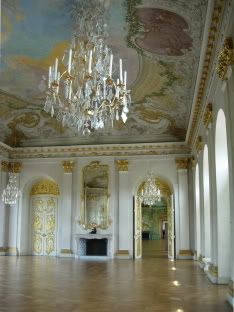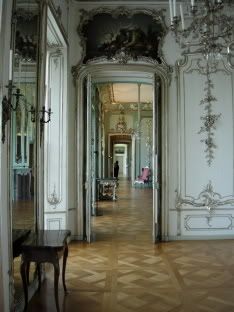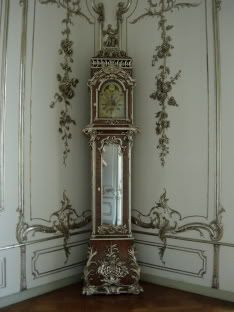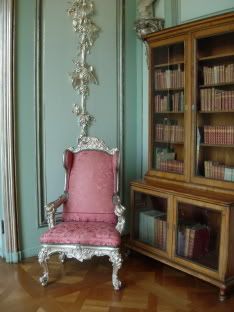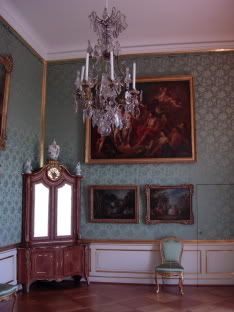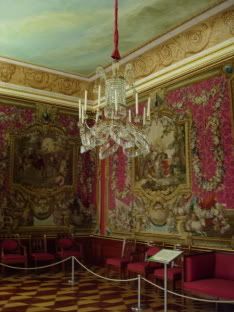Mit manchen Dingen ist die Richterin schlicht überfordert. Mit der Bedienungsanleitung für ihr Bürotelefon zum
Beispiel. Oder mit Bohrmaschinen, Zauberwürfeln und dem Knopflochstich ihrer Nähmaschine. Und mit Grossstädten.
Mit London war die Richterin nie überfordert. Aber London ist ja auch keine Grossstadt. Jedenfalls nicht mehr, seit die
Richterin für sieben Tage in Berlin war.
Some things are just too taxing for the Richterin. Like the user manual for her office phone. Like drilling machines, Rubik's cubes and the button hole stitch of her sewing machine. Or large cities. London was never too taxing for the Richterin. But then, London isn't a big city. Not since the Richterin went to Berlin for seven days.
1. Tag (8. Juni 2010) / Day 1 (8th June 2010)
Anreise / Arrival
Dem Automaten am Flughafen Tegel liess sich erst mal nur mit Hilfe eines Angestellten eine Fahrkarte zum Alexanderplatz entlocken. Letzterer ist ungefähr halb so gross wie die Schweiz, und wenn dort kein Fernsehturm rumstehen würde, an dem man sich orientieren kann, würde die Richterin vermutlich noch heute dort herumirren.
It was only with the help of a staff member that the ticket vending machine could be bothered to selling the Richterin a ticket to the Alexanderplatz. The latter is is a public square about half the size of Switzerland, and if it wasn't for the TV tower standing next to it and servin as a great reference point, the Richterin would probably still be wandering about the place.
Some things are just too taxing for the Richterin. Like the user manual for her office phone. Like drilling machines, Rubik's cubes and the button hole stitch of her sewing machine. Or large cities. London was never too taxing for the Richterin. But then, London isn't a big city. Not since the Richterin went to Berlin for seven days.
1. Tag (8. Juni 2010) / Day 1 (8th June 2010)
Anreise / Arrival
Dem Automaten am Flughafen Tegel liess sich erst mal nur mit Hilfe eines Angestellten eine Fahrkarte zum Alexanderplatz entlocken. Letzterer ist ungefähr halb so gross wie die Schweiz, und wenn dort kein Fernsehturm rumstehen würde, an dem man sich orientieren kann, würde die Richterin vermutlich noch heute dort herumirren.
It was only with the help of a staff member that the ticket vending machine could be bothered to selling the Richterin a ticket to the Alexanderplatz. The latter is is a public square about half the size of Switzerland, and if it wasn't for the TV tower standing next to it and servin as a great reference point, the Richterin would probably still be wandering about the place.
Ihrer langjährigen Wandererfahrung hat es die Richterin schliesslich auch zu verdanken, dass sie auf dem Fussmarsch zur
Ferienwohnung nicht vor Erschöpfung zusammenbrach. Eigentlich hätte sie ja schon beim Anblick vom Alex begreifen
sollen, dass in Berlin alles etwas grösser ist als in Bern. Oder in London. Nach einer dreiviertel Stunde und etwa zwanzig
mit knuffigen Männchen bestückten Fussgängerampeln kam die Richterin dann doch noch in der richtigen Strasse
an und freute sich bereits, dass ihre Odyssee damit ein Ende hatte. Bis zu diesem Zeitpunkt hatte sie ja aber auch noch keine
Bekanntschaft mit der Berliner Architektur gemacht. Nun gut, irgendwann war auch das "zweite Quergeb&aauml;ude" hinter dem
zweiten Innenhof jenseits des ersten Innenhofes gefunden, und nach tatkräftigem Einschreiten des Vermieters gab
schlussendlich sogar die feindlich gesinnte Balkontür den Weg auf den Balkon frei, wo die Richterin erst mal die Füsse
hochlegte.
It was probably only due to her long-time hiking experience that the Richterin didn't collapse on the way to her holiday flat. When seeing the Alexanderplatz, she should have realised that in Berlin everything is a bit bigger than in Bern. Or in London. After about three-quarters of an hour and twenty traffic lights - all equipped with twee little men - the Richterin finally reached the right street and felt happy that her odyssee was over. Up to that point, however, she had never gotten in touch with Berlin architecture. But finally, she also found the "second transversal building" behind the second inner courtyard beyond the first courtyard, and after a dynamic intervention of her landlord, the hostile French window gave way to the balcony where the Richterin put up her feet for the rest of the day.
It was probably only due to her long-time hiking experience that the Richterin didn't collapse on the way to her holiday flat. When seeing the Alexanderplatz, she should have realised that in Berlin everything is a bit bigger than in Bern. Or in London. After about three-quarters of an hour and twenty traffic lights - all equipped with twee little men - the Richterin finally reached the right street and felt happy that her odyssee was over. Up to that point, however, she had never gotten in touch with Berlin architecture. But finally, she also found the "second transversal building" behind the second inner courtyard beyond the first courtyard, and after a dynamic intervention of her landlord, the hostile French window gave way to the balcony where the Richterin put up her feet for the rest of the day.
2. Tag (9. Juni 2010) / Day 2 (9th June 2010)
Schloss Charlottenburg / Charlottenburg Palace
Das Schloss Charlottenburg wurde zwischen 1695 und 1699 als Sommerresidenz von Sophie Charlotte, der Gemahlin von Kurfürst Friedrich III. errichtet und wurde in den folgenden Jahrzehnten kontinuierlich ausgebaut. Unter anderem entstand 1740 unter König Friedrich II. der Neue Flügel. Seine endgültige Form erhielt das Schloss unter König Friedrich Wilhelm II.
Charlottenburg Palace was built between 1695 and 1699 as the summer residence of Sophie Charlotte, wife of Elector Frederick III and was continuously expanded during the following decades.In 1740, the New Wing was built Under King Frederick II. The Palace received its final shape under King Frederick William II.
Schloss Charlottenburg / Charlottenburg Palace
Das Schloss Charlottenburg wurde zwischen 1695 und 1699 als Sommerresidenz von Sophie Charlotte, der Gemahlin von Kurfürst Friedrich III. errichtet und wurde in den folgenden Jahrzehnten kontinuierlich ausgebaut. Unter anderem entstand 1740 unter König Friedrich II. der Neue Flügel. Seine endgültige Form erhielt das Schloss unter König Friedrich Wilhelm II.
Charlottenburg Palace was built between 1695 and 1699 as the summer residence of Sophie Charlotte, wife of Elector Frederick III and was continuously expanded during the following decades.In 1740, the New Wing was built Under King Frederick II. The Palace received its final shape under King Frederick William II.
Den schönsten Blick auf die Anlage hat man vom Schlosspark aus (siehe erstes Bild). Bei gutem Wetter empfiehlt
sich ein Spaziergang. Der Park ist sehr idyllisch und gross genug, dass man sich darin verlaufen kann (zumindest hat
das die Richterin geschafft). Zwischen den Bäumen verstecken sich u. a. ein Ententeich, ein Mausoleum mit den Sarkophagen
diverser Hoheiten und ein "Theeschlösschen" (das
Teehaus Belvedere, 3. Bild unten).
The nicest view of the palace and its gardens can be enjoyed from the park grounds (first picture). The park is very idyllic and big enough to get lost (at least the Richterin somehow managed to do so). Various things are hiding between the trees, like a duck pond, a mausoleum containing the sarcophagi of several majesties and a "little tea palace" (the tea house "Belvedere", third picture below).
The nicest view of the palace and its gardens can be enjoyed from the park grounds (first picture). The park is very idyllic and big enough to get lost (at least the Richterin somehow managed to do so). Various things are hiding between the trees, like a duck pond, a mausoleum containing the sarcophagi of several majesties and a "little tea palace" (the tea house "Belvedere", third picture below).
In den Innenräumen findet man alles, was zwischen Barock und Spätklassizismus liegt. Ich habe nur den neuen Flügel
besucht, das war teuer genug (fürs Fotografieren ohne Blitz und Stativ darf man sogar drei Euro extra abdrücken),
und man kann sich dort locker zwei Stunden beschäftigen. Besonders beeindruckend ist der Festsaal, wobei ich mich mit dem
modernen Gekrakel, das 1977 im Laufe der nachkriegszeitlichen Restaurationsarbeiten an die Decke gepinselt wurde und angeblich
"dem Eindruck des Baus nachempfunden" ist, nicht so recht anfreunden konnte. Gemäss
Wikipedia ist dessen Schöpfer Peter Schubert ein Vertreter der informellen Kunst (offenbar muss man das kennen),
"welche keinen einheitlichen Stil meint, sondern eine künstlerische Haltung charakterisiert, die das klassische
Form- und Kompositionsprinzip ebenso ablehnt wie die geometrische Abstraktion. Konstitutiv ist das Prinzip der
Formlosigkeit im Spannungsfeld von Formauflösung und Formwerdung. (Ich gebe zu, dass ich keinen Schimmer habe, was
mir Wikipedia bzw. der zitierte Kunstkritiker damit sagen will und gebe mich an dieser Stelle mit dem Prinzip der
Geschmacklosigkeit im Spannungsfeld zwischen Rokoko und Nachkriegskunst zufrieden.)
In the interior rooms, you will find anything and everything between Baroque and late Classicism. I only visited the New Wing which was expensive enough (you will even have to pay 3 euros extra if you want to take pictures without flashlight and tripod), and was able to keep myself busy for a good two hours. The ballroom is particularly impressive, although the Richterin couldn't warm to the modern scrawl that was brushed onto the ceiling in the course of the restoring work in 1997 and is claimed to be based on the "impression of the building" According to wikipedia, its creator Peter Schubert is a representative of Informal Art (apparently one is supposed to know this kind of style) "that does not hold a particular style, but characterizes an artistic attitude which disapproves of the classic principles regarding shape and composition in the same way it disapproves of geometrical abstraction. The principle of lack of shape in the conflicting fields between dissolution of shape and shaping is constitutive. (I happily admit that I don't have the slightest idea what wikipedia or rather the art critic quoted in the article is trying to tell me, and I'll do with the principle of the lack of taste in the conflicting areas between Rococo and postwar art at this point.)
In the interior rooms, you will find anything and everything between Baroque and late Classicism. I only visited the New Wing which was expensive enough (you will even have to pay 3 euros extra if you want to take pictures without flashlight and tripod), and was able to keep myself busy for a good two hours. The ballroom is particularly impressive, although the Richterin couldn't warm to the modern scrawl that was brushed onto the ceiling in the course of the restoring work in 1997 and is claimed to be based on the "impression of the building" According to wikipedia, its creator Peter Schubert is a representative of Informal Art (apparently one is supposed to know this kind of style) "that does not hold a particular style, but characterizes an artistic attitude which disapproves of the classic principles regarding shape and composition in the same way it disapproves of geometrical abstraction. The principle of lack of shape in the conflicting fields between dissolution of shape and shaping is constitutive. (I happily admit that I don't have the slightest idea what wikipedia or rather the art critic quoted in the article is trying to tell me, and I'll do with the principle of the lack of taste in the conflicting areas between Rococo and postwar art at this point.)
